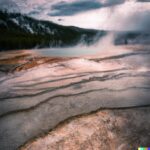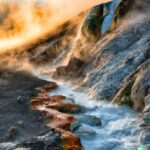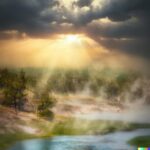Welcome to the wonders of the Yellowstone Grand Geyser Basin! This article will take you on a journey through the geology, history, and must-see features of this remarkable natural wonder. From the iconic Old Faithful Geyser to the stunning Grand Prismatic Spring, you will learn about the unique geysers and hot springs that make this area so special.
Discover the best time to visit, activities to enjoy, and entrance fees for an unforgettable experience in one of the world’s most incredible geothermal areas.
What is the Yellowstone Grand Geyser Basin?
The Yellowstone Grand Geyser Basin is a remarkable area within Yellowstone National Park known for its spectacular geothermal features, including geysers, hot springs, and thermal vents.
It is considered one of the top geothermal hotspots in the world, attracting visitors with its diverse range of hydrothermal formations. The basin showcases a mesmerizing array of geysers shooting columns of boiling water into the air, hot springs bubbling with vibrant colors due to microbial life, and hissing thermal vents releasing steam and gases from deep within the Earth. These geological wonders highlight the dynamic nature of geothermal activity, where underground water interacts with molten rock to create these natural marvels over thousands of years.
Where is the Yellowstone Grand Geyser Basin Located?
The Yellowstone Grand Geyser Basin is situated in the iconic Yellowstone National Park, located in the state of Wyoming.
This awe-inspiring geothermal wonderland is known for its bubbling hot springs, vividly colorful pools, and erupting geysers, including the world-famous Old Faithful. Yellowstone’s unique geological landscape is a result of being situated atop a supervolcano, with the park boasting over half of the world’s geysers. Visitors can witness the raw power of nature as steam rises from various vents, hot springs paint the ground with vibrant hues, and geysers unleash scalding water high into the air. Each feature in the Grand Geyser Basin tells a story of the Earth’s dynamic forces at work.
What is the Geology of the Yellowstone Grand Geyser Basin?
The geology of the Yellowstone Grand Geyser Basin is a captivating blend of diverse geological formations and unique geologic features shaped by volcanic activity and hydrothermal processes.
These geological wonders offer a glimpse into the dynamic processes that have sculpted the landscape over millions of years. Volcanic eruptions in the past have left behind a legacy of underground heat sources that power the hydrothermal features seen today. The interaction of hot fluids with the earth’s crust has given rise to a stunning array of colorful hot springs, bubbling mud pots, and towering geysers. This geological kaleidoscope showcases the intricate dance between heat, water, and rocks, resulting in the mesmerizing sights that draw visitors from around the globe.
What is the Yellowstone Caldera?
The Yellowstone Caldera, a massive volcanic crater at the heart of Yellowstone National Park, serves as a testament to the region’s tumultuous geologic history and ongoing volcanic activity.
This geological wonder was formed over millions of years through a series of volcanic eruptions, the most recent being around 640,000 years ago. The caldera, measuring about 45 miles by 30 miles, is one of the largest of its kind on Earth. Its significance lies in the fact that it continues to influence the park’s landscape and features, shaping the diverse ecosystems and contributing to the numerous geothermal features such as geysers, hot springs, and fumaroles scattered throughout Yellowstone. The violent eruptions that occurred in the past have left a lasting impact, showcasing the raw power of nature and the ongoing geological processes at play.
What are the Types of Geysers in the Basin?
The Yellowstone Grand Geyser Basin boasts a variety of geysers with distinct eruption patterns and temperature fluctuations, showcasing the dynamic nature of these captivating hydrothermal features.
Visitors to the basin can witness a range of geysers, each with its own unique characteristics. For example, the Old Faithful Geyser erupts approximately every 90 minutes, while the erratic Steamboat Geyser can go for weeks or even years between eruptions before putting on a spectacular show. With temperatures ranging from near boiling to cooler thermal pools, these geysers provide a glimpse into the fiery underground activity that shapes the landscape.
What is the History of the Yellowstone Grand Geyser Basin?
The history of the Yellowstone Grand Geyser Basin is a tale of geological wonder and environmental significance, reflecting the area’s rich past and ecological balance.
This remarkable basin, located in Yellowstone National Park, was formed over millions of years through volcanic activity and shifting tectonic plates. Its stunning geysers, hot springs, and bubbling mud pots showcase the Earth’s raw power and constant transformation. The unique geological features attract visitors worldwide, but they also serve as critical habitats for diverse flora and fauna, contributing to the area’s ecological richness. Yellowstone Grand Geyser Basin plays a crucial role in understanding the planet’s geological history and the importance of preserving fragile ecosystems.
What is the Best Time to Visit the Yellowstone Grand Geyser Basin?
The best time to visit the Yellowstone Grand Geyser Basin is during the seasons that showcase its thermal landscapes in all their glory, making it an ideal destination for tourists seeking natural wonders.
During the spring and early summer months, visitors can witness the vibrant rebirth of the basin’s flora and fauna, set against a backdrop of erupting geysers and colorful hot springs. As temperatures warm up, the geothermal activity becomes more pronounced, creating a mesmerizing display of steam and boiling water.
In the fall, the basin transforms with the changing foliage, offering a picturesque contrast to the bubbling thermal features. Winter brings a magical ambiance, as snow blankets the landscape, enhancing the stark beauty of the geysers against the white backdrop.
Each season offers a unique perspective on this geological marvel, providing visitors with a year-round opportunity to marvel at the wonders of Yellowstone Grand Geyser Basin.
What are the Must-See Features in the Yellowstone Grand Geyser Basin?
Exploring the Yellowstone Grand Geyser Basin unveils a plethora of must-see features, including iconic attractions like the Old Faithful Geyser that epitomize the geothermal wonders of the region.
Witnessing the spectacular eruptions of Old Faithful is just the beginning of the mesmerizing journey through this unique landscape. As visitors traverse the boardwalks and trails, they encounter a symphony of geothermal marvels, from colorful hot springs like Grand Prismatic to the bubbling mud pots of Fountain Paint Pots.
Each attraction tells a story of the Earth’s inner workings, showcasing the power of thermal features that have shaped this area over thousands of years. The bubbling pools and steaming vents create an otherworldly experience that truly highlights the natural phenomena at play.
Old Faithful Geyser
Old Faithful Geyser, a legendary thermal feature in Yellowstone National Park, mesmerizes visitors with its predictable eruption intervals and stunning display of geothermal power.
This iconic geyser, named for its reliable and frequent eruptions, showcases the incredible forces at work beneath the Earth’s surface. The eruptions, which can shoot scalding water up to 180 feet into the air, occur roughly every 90 minutes, creating a spectacle that symbolizes the raw energy of Yellowstone’s geothermal wonders.
Not only does Old Faithful serve as a prime example of the park’s hydrothermal activity, but it also demonstrates the geological significance of the region’s volcanic past and ongoing subterranean processes.
Grand Prismatic Spring
The Grand Prismatic Spring, one of Yellowstone’s iconic hot spots, captivates onlookers with its vibrant colors, silica-rich waters, and unique geological formations.
The brilliant hues of the spring, ranging from deep blues to fiery oranges, are a testament to the microbial mats that flourish in its warm waters. These colors, a result of different pigmented bacteria living in the varying temperature zones of the pool, create a breathtaking visual display. The silica-rich waters not only contribute to the striking appearance but also foster the growth of the intricate microbial structures that form around the spring.
As one gazes upon the Grand Prismatic Spring, it’s like peering into a living, breathing artwork shaped by the forces of nature over millennia.
Morning Glory Pool
The Morning Glory Pool mesmerizes visitors with its vivid colors, showcasing rare flora and intricate bacterial mats that add to the pool’s allure and ecological diversity.
The vibrant hues of the pool, ranging from deep blues to fiery oranges, create a striking contrast against the lush greenery that surrounds it. This unique blend of colors is not only visually captivating but also an indicator of the diverse ecosystem thriving within.
The presence of thermophilic bacteria in the mats contributes to the stunning visual display, forming intricate patterns that resemble delicate tapestries. These bacterial colonies play a crucial role in maintaining the fragile balance of the pool’s ecosystem, supporting a myriad of rare plant species that have adapted to thrive in this microcosm of life.”
Castle Geyser
Castle Geyser, a majestic geothermal feature in Yellowstone, enchants viewers with its towering eruptions and the mineral deposits that adorn its surroundings, a testament to the region’s thermal activity.
Its eruption patterns, characterized by powerful bursts that can reach heights of up to 90 feet, set it apart from other geysers in the park. The mineral deposits left behind after each eruption create a surreal landscape of vibrant colors, with hues ranging from delicate pinks to deep oranges, offering a visual feast for onlookers. Castle Geyser serves as a living canvas of Yellowstone’s complex geological processes, where the interplay of heat, water, and minerals gives rise to a dynamic display that captivates and educates visitors.
Riverside Geyser
The Riverside Geyser captivates spectators with its picturesque eruptions that reflect in the nearby hot water pools, highlighting the area’s diverse geological features and hydrothermal allure.
As visitors witness the Riverside Geyser’s eruptions, they are encompassed by a fascinating interplay of water and steam, creating a mesmerizing display against the backdrop of Yellowstone’s thermal landscape. The geyser’s location within the vivid scenery amplifies the beauty of its performances, drawing attention to the intricate connection between the geothermal activity and the surrounding environment. The bubbling hot water pools nearby reveal the underlying volcanic forces that shape the area, offering a glimpse into the Earth’s natural and dynamic processes.
Grotto Geyser
The Grotto Geyser enthralls visitors with its steam vents and diverse ecosystem, offering a glimpse into the intricate hydrothermal environment that defines Yellowstone National Park.
With its hissing steam vents that punctuate the air and the bubbling pools of hot water, the Grotto Geyser stands as a prime example of nature’s power and beauty. Alongside the geyser, a rich tapestry of plant life thrives, creating a delicate balance within the surrounding ecosystem. This unique combination of geothermal activity and biodiversity showcases the park’s commitment to preserving its natural wonders while providing a habitat for a wide array of flora and fauna. Visitors are often captivated by the harmony between the geyser’s dramatic displays and the intricate web of life that flourishes in its shadow.
What Activities Can You Do at the Yellowstone Grand Geyser Basin?
Visitors to the Yellowstone Grand Geyser Basin can engage in a variety of activities such as hiking through scenic trails, camping in the wilderness, observing wildlife in their natural habitat, and capturing stunning moments through photography.
- Exploring the hiking trails in the Grand Geyser Basin allows one to immerse themselves in the pristine beauty of nature while getting some exercise.
- Camping beneath the starry skies provides a unique opportunity to truly connect with the park’s wilderness.
- Observing the wildlife, from bison to bears, offers a chance to witness these majestic creatures in their natural environment.
- Photography enthusiasts will be thrilled by the endless opportunities to capture the breathtaking landscapes and geothermal features of the park.
Each activity promises a memorable and enriching experience for visitors.
Hiking
Hiking in the Yellowstone Grand Geyser Basin offers an immersive experience amidst geothermal wonders and picturesque landscapes, allowing visitors to appreciate the scenic beauty and natural phenomena of the region.
Exploring the hiking trails in this area provides a unique opportunity to witness steaming geysers, colorful hot springs, and bubbling mud pots that showcase the park’s fascinating thermal landscapes. Meandering through these paths, hikers can marvel at the raw power and beauty of nature’s geological spectacles, feeling a sense of awe at each turn. The grandeur of the geysers erupting against the backdrop of rugged mountains and lush forests creates a captivating juxtaposition that lures adventurers deeper into the heart of this remarkable ecosystem.
Camping
Camping in the Yellowstone Grand Geyser Basin allows visitors to immerse themselves in nature, experience the park’s ecological balance firsthand, and enjoy the region’s status as a premier tourist destination.
Surrounded by the captivating beauty of geothermal features, lush forests, and diverse wildlife, camping in this iconic location offers a myriad of opportunities to witness the park’s natural wonders up close. From the bubbling hot springs to the majestic geysers like Old Faithful, campers have a front-row seat to the exceptional biodiversity that thrives in Yellowstone.
The camping facilities cater to various preferences, ranging from rustic tent sites to RV hook-ups, ensuring that visitors can enjoy the park’s serene environment without compromising on comfort.
Wildlife Viewing
Wildlife viewing in the Yellowstone Grand Geyser Basin offers a chance to observe animals in their natural habitat, amidst the backdrop of thermal features and geological wonders that define the region’s unique ecosystem.
This remarkable setting provides a captivating opportunity for wildlife enthusiasts to witness a wide array of animal species thriving in harmony with the natural geothermal phenomena of the area. Yellowstone’s Grand Geyser Basin serves as a sanctuary not only for iconic species like bears, wolves, and bison but also for a multitude of bird species and smaller mammals. The park’s commitment to wildlife conservation plays a crucial role in protecting this incredible ecosystem, ensuring the preservation of its ecological diversity for future generations to admire and learn from.
Photography
Photography enthusiasts can capture the essence of Yellowstone’s natural history and thermal wonders through stunning images that showcase the park’s unique landscape and ecological diversity.
Exploring Yellowstone with a camera in hand offers a chance to freeze time and immortalize the dynamic forces of nature at play. As the world’s first national park, Yellowstone’s geysers, hot springs, and bubbling mud pots serve as a visual reminder of Earth’s raw power and ancient past.
When photographing these thermal features, consider the interplay of light and shadows to emphasize textures and colors, or experiment with long exposure shots to capture the movement of boiling water or billowing steam. Don’t forget to also focus on the park’s wildlife, from majestic bison to elusive wolves, adding depth and life to your photographic narrative.
What is the Entrance Fee for the Yellowstone Grand Geyser Basin?
The entrance fee for the Yellowstone Grand Geyser Basin serves as a gateway to experiencing the wonders of this iconic tourist attraction within Yellowstone National Park.
Visitors must pay a fee to access the Grand Geyser Basin, ranging from $15 to $35 depending on the type of pass chosen, such as single-day entry or an annual park pass. These fees help support the maintenance and preservation of the park’s geothermal features and natural landscapes. By investing in these entrance fees, visitors contribute to the conservation efforts that protect the unique environment and wildlife within Yellowstone. It’s a small price to pay for the opportunity to witness nature’s raw beauty and learn about the geological processes shaping this stunning destination.
Last Updated on February 7, 2024 by Jon Waraas – Originally Posted: February 7, 2024

I’m Jon Waraas, and I’ve been navigating the online world since 2006. By day, I’m the proud owner of some eCommerce gems, and by night, I’m the voice behind the adventures on Waraas.Com.
My heart, however, belongs to the wild beauty of Yellowstone National Park. I’ve got a collection of websites dedicated to sharing the wonders of this natural masterpiece. Oh, and did I mention? I’m currently building my own cabin inside the ghost town of Gilmore, Idaho – a cabin with tales to tell!
When I’m not immersed in the digital realm, you’ll find me lacing up my boots for a good hike or setting up camp under the star-studded sky.




